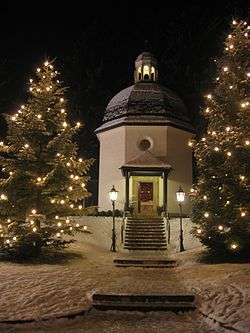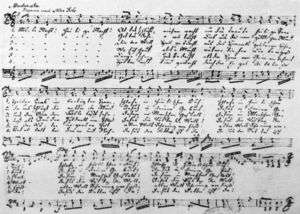Silent Night
| Silent Night | |
|---|---|
| by Franz Xaver Gruber | |
| Native name | Stille Nacht, heilige Nacht |
| Genre | Christmas, religious |
| Text | Joseph Mohr |
| Language | German |
| Performed | 24 December 1818 |
.jpg)
"Silent Night" (German: Stille Nacht, heilige Nacht) is a popular Christmas carol, composed in 1818 by Franz Xaver Gruber to lyrics by Joseph Mohr in the small town of Oberndorf bei Salzburg, Austria. It was declared an intangible cultural heritage by UNESCO in 2011.[1] The song has been recorded by a large number of singers from every music genre. The version sung by Bing Crosby is the third best-selling single of all-time.
History
The song was first performed on Christmas Eve 1818 at St Nicholas parish church in Oberndorf, a village in the Austrian Empire on the Salzach river in present-day Austria. A young priest, Father Joseph Mohr, had come to Oberndorf the year before. He had written the lyrics of the song "Stille Nacht" in 1816 at Mariapfarr, the hometown of his father in the Salzburg Lungau region, where Joseph had worked as a co-adjutor.
The melody was composed by Franz Xaver Gruber, schoolmaster and organist in the nearby village of Arnsdorf. Before Christmas Eve, Mohr brought the words to Gruber and asked him to compose a melody and guitar accompaniment for the Christmas Eve mass.[2] Together they performed the new carol during the mass on the night of 24 December.
The original manuscript has been lost. However, a manuscript was discovered in 1995 in Mohr's handwriting and dated by researchers as c. 1820. It states that Mohr wrote the words in 1816 when he was assigned to a pilgrim church in Mariapfarr, Austria, and shows that the music was composed by Gruber in 1818. This is the earliest manuscript that exists and the only one in Mohr's handwriting.
The first edition was published by Friese in 1833 in a collection of Four Genuine Tyrolean Songs, with the following musical text:[3]
The contemporary version, as in the choral example below, is:
Translations

In 1859, the Episcopal priest John Freeman Young, then serving at Trinity Church, New York City, wrote and published the English translation that is most frequently sung today, translated from three of Mohr's original six verses.[4] The version of the melody that is generally used today is a slow, meditative lullaby or pastorale, differing slightly (particularly in the final strain) from Gruber's original, which was a "moderato" tune in 6
8 time and siciliana rhythm.[5][6] Today, the lyrics and melody are in the public domain.
The carol has been translated into about 140 languages.[7][8]
Lyrics
 |
|
| Problems playing these files? See media help. | |

Mohr's German lyrics Young's English lyrics[9] Stille Nacht, heilige Nacht,
Alles schläft; einsam wacht
Nur das traute hochheilige Paar.
Holder Knabe im lockigen Haar,
Schlaf in himmlischer Ruh!
Schlaf in himmlischer Ruh!
Stille Nacht, heilige Nacht,
Hirten erst kundgemacht
Durch der Engel Halleluja,
Tönt es laut von fern und nah:
Christ, der Retter ist da!
Christ, der Retter ist da!
Stille Nacht, heilige Nacht,
Gottes Sohn, o wie lacht
Lieb' aus deinem göttlichen Mund,
Da uns schlägt die rettende Stund'.
Christ, in deiner Geburt!
Christ, in deiner Geburt!Silent night, holy night,
All is calm, all is bright
Round yon virgin mother and child.
Holy infant, so tender and mild,
Sleep in heavenly peace,
Sleep in heavenly peace.
Silent night, holy night,
Shepherds quake at the sight;
Glories stream from heaven afar,
Heavenly hosts sing Alleluia!
Christ the Savior is born,
Christ the Savior is born!
Silent night, holy night,
Son of God, love's pure light;
Radiant beams from thy holy face
With the dawn of redeeming grace,
Jesus, Lord, at thy birth,
Jesus, Lord, at thy birth.
Musical settings
Max Reger quotes the tune in the Christmas section of his organ pieces Sieben Stücke, Op. 145.
In film
Several theatrical and television films depict how the song was ostensibly written. Most of them however are based on a spurious legend, about the organ breaking down at the church in Oberndorf, which appeared in a fictional story published in the U.S. in the 1930s.[2]
- The Legend of Silent Night (1968) TV film directed by Daniel Mann
- Silent Night, Holy Night (1976) animated short film by Hanna-Barbera.[10]
- Silent Mouse (1988) television special directed and produced by Robin Crichton and narrated by Lynn Redgrave.[11]
- Buster & Chauncey's Silent Night (1998) direct-to-video animated featurette[12]
- Stille Nacht (2012) directed by Christian Vuissa[13]
- The First Silent Night (2014), documentary narrated by Simon Callow[14]
References
- ↑ "Österreichische UNESCO-Kommission – Nationalagentur für das Immaterielle Kulturerbe – Austrian Inventory". Retrieved 25 December 2014.
- 1 2 "Christmas carols". BBC. 4 August 2009. Retrieved 6 December 2011.
- ↑ "Silent Night" revisited by Norbert Müllemann, G. Henle Verlag, 24 December 2012
- ↑ Underwood, Byron Edward, "Bishop John Freeman Young, Translator of 'Stille Nacht'", The Hymn, v. 8, no. 4, October 1957, pp. 123–132.
- ↑ Meredith Ellis Little (2001). Siciliana. Grove Music Online. ISBN 978-1561592630.
- ↑ Gerlinde Haid (1994). Siciliano als Typus weihnachtlicher Volksmusik. 175 Jahre "Stille Nacht! Heilige Nacht!" (in German), p.135–146. Salzburg.
- ↑ Ronald M. Clancy, William E Studwell. Best-Loved Christmas Carols. Christmas Classics Ltd, 2000.
- ↑ "Silent Night". Silent Night Web.
- ↑ "Silent Night, Holy Night", The United Methodist Hymnal, number 239, translated by John F. Young (stanzas 1–3) and anon. (stanza 4), hymnsite.com
- ↑ "Silent Night, Holy Night (TV Movie 1976)". IMDb. 27 December 2008. Retrieved 17 February 2017.
- ↑ "Silent Mouse (1988)". Turner Classic Movies. Retrieved 29 November 2015.
- ↑ "Buster and Chauncey's Silent Night". TCM. Retrieved 23 November 2016.
- ↑ "SILENT NIGHT | Movieguide | Movie Reviews for Christians". Movieguide. Retrieved 17 February 2017.
- ↑ First Silent Night, The, production details
External links
| Wikisource has original text related to this article: |
| German Wikisource has original text related to this article: |
 Media related to Stille Nacht at Wikimedia Commons
Media related to Stille Nacht at Wikimedia Commons- Free arrangements for piano and voice from Cantorion.org
- Text and music, Stille-Nacht-Association, Salzburg
- Silent Night Chapel, origin of song